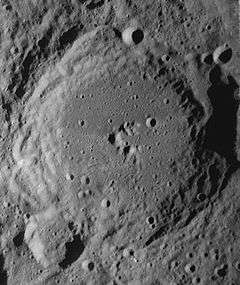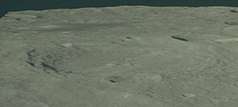Wiener (crater)
Wiener is a lunar impact crater that lies on the Moon's far side. It is located just to the southwest of the larger crater Campbell. To the southwest of Wiener is the heavily worn Kurchatov. To the east along the rim of Campbell is Von Neumann. The smaller crater Pawsey lies to the north-northwest, and is partly overlain by the outer rampart of Wiener.
 LRO WAC image | |
| Coordinates | 40.8°N 146.6°E |
|---|---|
| Diameter | 120 km |
| Depth | Unknown |
| Colongitude | 215° at sunrise |
| Eponym | Norbert Wiener |


The northwestern half of the crater rim is well-formed, with some slumping and terraces along the inner walls. There is an outward protrusion in the rim along the northern side where the crater borders along Pawsey. The southern part of the crater is more irregular, with a wider, uneven inner wall and a poorly defined rim edge. The rim overlies about half of the heavily worn satellite crater Wiener K along the south-southeast. The smaller satellite crater Wiener Q lies along the southwestern rim, and the relatively fresh and polygon-shaped Wiener F is attached to the eastern rim.
Within the crater, much of the interior floor is relatively level, with a clump of small ridges forming a central peak structure near the midpoint. There is a small craterlet to the east-northeast of these ridges, and there are several small craterlets near the southwestern inner wall.
Satellite craters
By convention these features are identified on lunar maps by placing the letter on the side of the crater midpoint that is closest to Wiener.
| Wiener | Latitude | Longitude | Diameter |
|---|---|---|---|
| F | 41.2° N | 150.0° E | 47 km |
| H | 39.8° N | 149.9° E | 17 km |
| K | 39.3° N | 147.8° E | 101 km |
| Q | 39.5° N | 145.0° E | 30 km |
 Oblique view of the young crater Wiener F, from Lunar Orbiter 5
Oblique view of the young crater Wiener F, from Lunar Orbiter 5 Oblique view of the interior of Wiener F, from LRO
Oblique view of the interior of Wiener F, from LRO
References
- Norbert Wiener autobiography - mentions that the lunar feature was named in his honor.
- Andersson, L. E.; Whitaker, E. A. (1982). NASA Catalogue of Lunar Nomenclature. NASA RP-1097.CS1 maint: ref=harv (link)
- Blue, Jennifer (July 25, 2007). "Gazetteer of Planetary Nomenclature". USGS. Retrieved 2007-08-05.CS1 maint: ref=harv (link)
- Bussey, B.; Spudis, P. (2004). The Clementine Atlas of the Moon. New York: Cambridge University Press. ISBN 978-0-521-81528-4.CS1 maint: ref=harv (link)
- Cocks, Elijah E.; Cocks, Josiah C. (1995). Who's Who on the Moon: A Biographical Dictionary of Lunar Nomenclature. Tudor Publishers. ISBN 978-0-936389-27-1.CS1 maint: ref=harv (link)
- McDowell, Jonathan (July 15, 2007). "Lunar Nomenclature". Jonathan's Space Report. Retrieved 2007-10-24.CS1 maint: ref=harv (link)
- Menzel, D. H.; Minnaert, M.; Levin, B.; Dollfus, A.; Bell, B. (1971). "Report on Lunar Nomenclature by the Working Group of Commission 17 of the IAU". Space Science Reviews. 12 (2): 136–186. Bibcode:1971SSRv...12..136M. doi:10.1007/BF00171763.CS1 maint: ref=harv (link)
- Moore, Patrick (2001). On the Moon. Sterling Publishing Co. ISBN 978-0-304-35469-6.CS1 maint: ref=harv (link)
- Price, Fred W. (1988). The Moon Observer's Handbook. Cambridge University Press. ISBN 978-0-521-33500-3.CS1 maint: ref=harv (link)
- Rükl, Antonín (1990). Atlas of the Moon. Kalmbach Books. ISBN 978-0-913135-17-4.CS1 maint: ref=harv (link)
- Webb, Rev. T. W. (1962). Celestial Objects for Common Telescopes (6th revised ed.). Dover. ISBN 978-0-486-20917-3.CS1 maint: ref=harv (link)
- Whitaker, Ewen A. (1999). Mapping and Naming the Moon. Cambridge University Press. ISBN 978-0-521-62248-6.CS1 maint: ref=harv (link)
- Wlasuk, Peter T. (2000). Observing the Moon. Springer. ISBN 978-1-85233-193-1.CS1 maint: ref=harv (link)